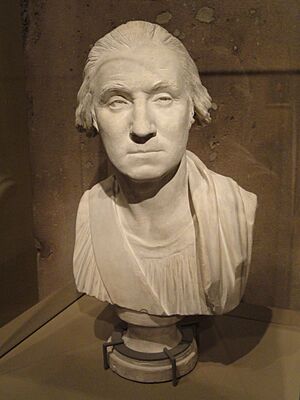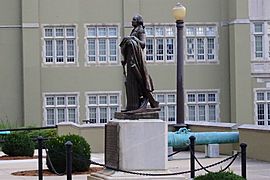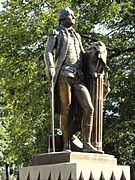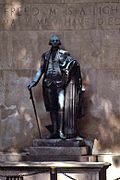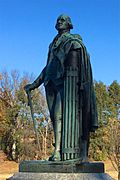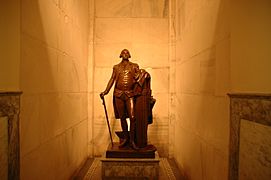Statue of George Washington (Houdon) facts for kids
Quick facts for kids George Washington |
|
|---|---|
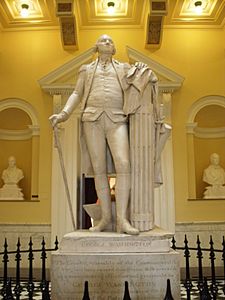
The original sculpture in Richmond, Virginia
|
|
| Artist | Jean-Antoine Houdon |
| Year | 1785–1792 |
| Medium | Carrara marble |
| Location | Virginia State Capitol, Richmond, Virginia |
| Owner | Commonwealth of Virginia |
The George Washington statue is a famous sculpture by French artist Jean-Antoine Houdon. He created it in the late 1700s. To make it very accurate, Houdon took a life mask of George Washington's face. He also took many other measurements.
Many people think this statue is one of the best and most accurate pictures of Washington. The first statue is in the Virginia State Capitol building in Richmond, Virginia. Many copies have been made, and one is in the United States Capitol Rotunda.
The statue was ordered by the Virginia General Assembly in 1784. Houdon started working on it in 1785. It was finished around 1791 or 1792. It finally arrived in Virginia in 1796.
Contents
What the Statue Looks Like
The first statue is made from Carrara marble. It weighs 18 tons. It shows George Washington standing up, life-sized. In his right hand, he holds a walking stick. His left arm rests on a fasces, which is a bundle of rods. His cape and sword hang from the fasces. Behind him, there is a plow.
Washington is wearing his military uniform. He wanted to be shown in clothes from his own time. This was different from other sculptures back then. Many sculptures showed people in old Roman or Greek clothes.
The statue includes items from both civilian life and military life. The plow and cane are civilian items. The fasces, sword, and uniform are military items. This mix of objects makes the statue special. It reminds people of an ancient Roman dictator named Cincinnatus. Cincinnatus was a farmer who became a leader. After winning battles, he went back to his farm. Washington was like Cincinnatus because he retired from public life. He did this after the American Revolutionary War.
Washington was also chosen as president of The Society of the Cincinnati in 1783. When the statue was ordered, Washington had not yet been president. He became president in 1789.
John Marshall, a very important judge who knew Washington, said the statue was perfect. He said, "Nothing in bronze or stone could be a more perfect image than this statue of the living Washington."
How Houdon Made the Original Statue
In 1784, the Virginia General Assembly wanted a statue of George Washington. They wanted it to be made from the "finest marble" by the "best workmanship." This meant they needed a European artist. The Governor of Virginia asked Thomas Jefferson, who was in France, to choose the artist. Jefferson and Benjamin Franklin suggested Jean-Antoine Houdon. He was the most famous sculptor at that time.
Houdon did not want to work only from a drawing of Washington. He wanted to see Washington in person. He also hoped to get another big job to make a statue of Washington on a horse. So, Houdon agreed to travel to the United States. He asked for his life to be insured for the trip. He wanted 10,000 French money units paid to his family if he died.
On July 28, 1785, Houdon sailed from England with Benjamin Franklin. He also brought two of his workers. They arrived in Philadelphia, Pennsylvania, on September 14.
In October 1785, Houdon and his assistants stayed at Washington's home, Mount Vernon. They took many detailed measurements of Washington's body. They also made a life mask of his face. By December, Houdon had returned to France.
The statue has the date "1788" carved on it. But it was finished in France in 1791 or 1792. It finally arrived in Richmond in 1796. It was placed in the capitol building on May 14, 1796. There were delays in shipping it. Some say it was because of the French Revolution. Others say payments to Houdon were slow. Most sources agree that the new Virginia State Capitol building was still being built. This stopped the statue from being put in place until it arrived.
The statue of Washington on a horse that Houdon hoped to make was never ordered. That statue was finally made in 1860 by Clark Mills. It is now in Washington Circle.
In the early 2000s, the statue was used for a special project. Experts used it, along with Houdon's life mask and bust, to recreate how George Washington looked at different ages. This was done by Mount Vernon.
Copies of the Statue
Starting in the 1800s, many copies of the statue were made. They were made from bronze and plaster. Molds were often taken directly from the original statue.
Hubard Casts
In 1831, a different statue of Washington was destroyed by fire. This made people worry that Houdon's statue might also be lost. So, in the 1850s, the Virginia General Assembly allowed 11 bronze copies to be made. Six of these were made by William James Hubard in Richmond.
Known copies made by Hubard are in these places:
- Virginia Military Institute in Lexington, Virginia. It was put there in 1856.
- North Carolina State Capitol in 1857. This was the first statue on the new capitol grounds. It replaced the one that burned.
- South Carolina State House grounds in Columbia, South Carolina. It was made in 1853 and put up in 1858.
- One copy moved around and ended up in Lafayette Park, St. Louis, Missouri in 1914.
- Rotunda of Alumni Hall at Miami University, Oxford, Ohio.
- New York City Hall. It was made in 1857 and bought in 1884.
A plaster copy by Hubard was once in the U.S. Capitol. In 1950, it moved to the Smithsonian American Art Museum. In 2007, it went to the Jamestown-Yorktown Foundation in Virginia.
-
George Washington cast by Hubard, at the Virginia Military Institute
-
At the North Carolina State Capitol
Gorham Casts
In the early 1900s (1908 or 1909), Virginia ordered a new copy. This copy was added to the National Statuary Hall Collection. It is now one of six state statues in the United States Capitol rotunda in Washington, D.C.
In 1910, a law was passed in Virginia. It allowed the Gorham Manufacturing Company to make more copies. They used molds that Virginia owned. These copies could be sold to governments, universities, schools, and other groups. Each copy had to have the Virginia state seal on it. It also had to say, "Copied from the original by Houdon..." Gorham paid Virginia $500 for each statue. The Virginia government later stopped new molds from being made. So, future copies came from the existing molds.
-
In the Valley Forge National Park
-
Inside the Washington Monument
Known locations of Gorham casts include:
- In 1910, Virginia gave a bronze copy to the people of France.
- Springfield, Massachusetts
- Jefferson Memorial Park, Pittsburgh, Pennsylvania, 1910
- Oshkosh, Wisconsin, 1911
- University of Virginia, Charlottesville, Virginia, dedicated 1913
- The Art Institute of Chicago, 1917. It was moved indoors in 1979. Now it is in the Chicago City Hall.
- Trafalgar Square in London, 1921
- Lima, Peru, dedicated July 4, 1922
- Philadelphia, Pennsylvania, 1922. It was first at the Philadelphia Museum of Art. Then it moved to Washington Square in 1954.
- National Heritage Museum, Lexington, Massachusetts; cast 1924
More copies were made for the 200th birthday of Washington. They are in these places:
- Fair Oaks Park, Minneapolis, Minnesota. It was given in 1931 and dedicated in 1932. It was taken down in November 2020.
- Valley Forge National Historical Park, Valley Forge, Pennsylvania
- Civic Center Plaza, Los Angeles, California; cast and given in 1933
- City College of New York, 1931
- Redwood Library and Athenaeum, Newport, Rhode Island. Dedicated 1932.
- Albany, New York, dedicated 1932
- The quad at George Washington University, 1932
- Maxwell School foyer at Syracuse University, 1937
Other Casts
A few more copies have been made since the Gorham castings:
- John M. Olin Library at Washington University in St. Louis, St. Louis, MO, cast 2004
- Larz Anderson House, headquarters of the Society of the Cincinnati, Washington, D.C., cast 2008
Many plaster copies were also made. One from 1932 is in the Indiana Statehouse in Indianapolis, Indiana. Another is in George Washington Hall at the University of Mary Washington in Fredericksburg, Virginia. It was made in the 1930s.
See also
 In Spanish: Estatua de George Washington (Houdon) para niños
In Spanish: Estatua de George Washington (Houdon) para niños
- List of monuments dedicated to George Washington
- List of statues of George Washington
- List of public art in Washington, D.C., Ward 2
- List of sculptures of presidents of the United States


